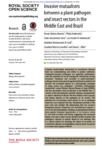Use este identificador para citar ou linkar para este item:
http://biblioteca.incaper.es.gov.br/digital/handle/item/2557| Título: | Invasive mutualisms between a plant pathogen and insect vectors in the Middle East and Brazil. |
| Autor(es): | QUEIROZ, R. B.  DONKERLEY, P.   SILVA, F. N.   AL-MAHMMOLI, I. H.   CARVALHO, C. M.   ELLIOT, S. L.   Renan Batista Queiroz, Incaper; Philip Donkersley, UFV; Fábio Nascimento Silva, UFV; Issa Hashil Al-Mahmmoli, College of Agricultural and Marine Sciences; Claudine Márcia Carvalho, UFV; Simon L. Elliot, UFV.   |
| Data do documento: | 10-Jan-2017 |
| Editor: | Royter Society Open Science, v. 3, dez. 2016. |
| Descrição: | Complex multi-trophic interactions in vectorborne diseases limit our understanding and ability to predict outbreaks. Arthropod-vectored pathogens are especially problematic, with the potential for novel interspecific interactions during invasions. Variations and novelties in plant arthropod pathogen triumvirates present significant threats to global food security. We examined aspects of a phytoplasma pathogen of citrus across two continents. Candidatus Phytoplasma aurantifolia causes Witches' Broom Disease of Lime (WBDL) and has devastated citrus production in the Middle East. A variant of this phytoplasma currently displays asymptomatic or silent infections in Brazil. We first studied vector capacity and fitness impacts of the pathogen on its vectors. The potential for co-occurring weed species to act as pathogen reservoirs was analysed and key transmission periods in the year were also studied. We demonstrate that two invasive hemipteran insects Diaphorina citri and Hishimonus phycitis can vector the phytoplasma. Feeding on phytoplasma-infected hosts greatly increased reproduction of its invasive vector D. citri both in Oman and Brazil; suggesting that increased fitness of invasive insect vectors thereby further increases the pathogen's capacity to spread. Based on our findings, this is a robust system for studying the effects of invasions on vectorborne diseases and highlights concerns about its spread to warmer, drier regions of Brazil. |
| URI: | http://biblioteca.incaper.es.gov.br/digital/handle/item/2557 |
| Aparece nas coleções: | Memória Técnica do Incaper  |
Arquivos associados a este item:
| Arquivo | Descrição | Tamanho | Formato | |
|---|---|---|---|---|
| BRT-invasivemutualisms-queiroz.pdf | 500,75 kB | Adobe PDF |  Visualizar/Abrir |
Os itens no repositório estão protegidos por copyright, com todos os direitos reservados, salvo quando é indicado o contrário.
